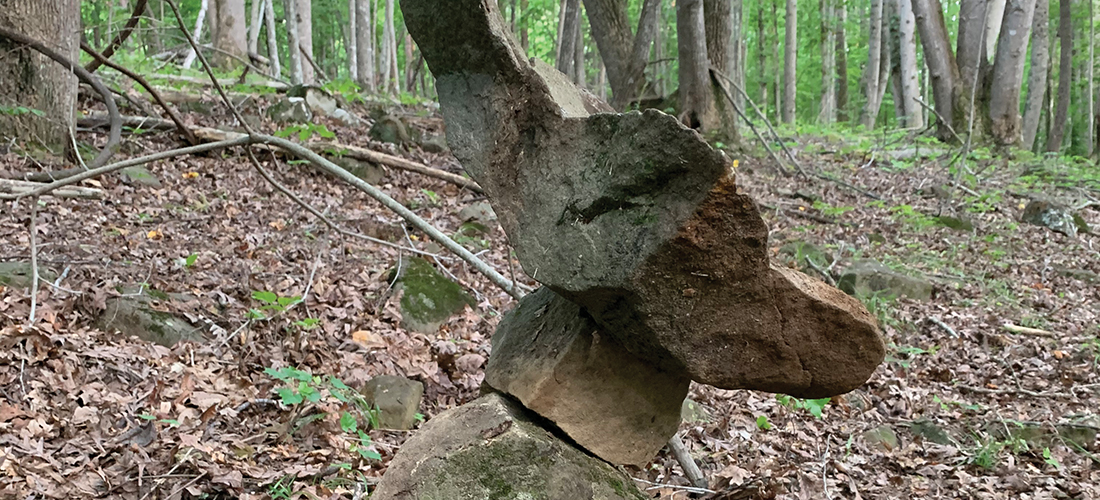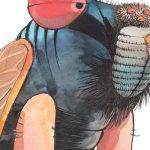
Set In Stone
Finding solace in the rocky lessons of nature
By Maria Johnson
He stopped suddenly on the trail ahead of me.
His eye had snagged something on the forest floor.
“We’d have something to work with here,” he said, nodding toward some mossy rubble. “I see some with good flat sides.”
He stepped through a blanket of dry leaves and stooped to dust off a level stone. This would be the foundation of his cairn, a dry stack of rock.
It didn’t take long for him to find a second stone, an orb the size of a jack-o-lantern, with an L-shaped niche chipped out.
He set the stone gently over one edge of the table rock. It nested snuggly, one hip flaring to the side.
“It’s nice if you can find a little bit of a cantilever,” he said.
Jim Overbey has been stacking rocks for a long time. He messed with them in the creek that ran through his childhood home, the Rolling Roads neighborhood of south Greensboro. After graduating from Ben L. Smith High School — “I’m a Ben L. man,” he says proudly — he packed off to N.C. State, where he became a student of horticulture, a grower of gardens, a man of plants and earth and, underneath it all, rock.
Sometimes, on pretty weekday afternoons, he and his college buddies would drive to Moore’s Wall at Hanging Rock State Park, or to Stone Mountain, to wedge their hands into crevices and pull themselves up rock faces that, in some places, leaned backward, beyond vertical. When the rains came, they scaled down off the big rocks and chilled under the overhangs, where they noodled with smaller rocks.
They stacked stones for fun and for competition — who could make the coolest, tallest, most precariously balanced tower? — but they never lingered for long because, sooner or later, the rain would wash out the day’s plans, or the sun would pop out, or set, and the Spider-Men would motor back to school, never expecting to see their loose stacks again.
Someone or something would knock them down, of course. But that didn’t stop Jim and his friends from building them during college, and in Jim’s case, for years to come. Whenever he walked the woods, he stacked.
“It’s a form of meditation for him,” says his wife, Mary. “He’s an artist.”
His dusty hands reach back in time. For as long as modern human’s have trod the earth — 300,000 years, give or take a few thousand — we have stacked rock, sometimes crudely, sometimes artfully, often to show the way to a spring, a trail, a property boundary or sacred site. Stonehenge. The faces of Easter Island. The pebbles left on Jewish graves by those who remember. All stones, all signs.
In the last few years, I’ve spotted cairns in the middle of rivers — showing the races most hospitable to kayakers — and on steep glacial mountainsides — indicating the next best step in a field of fractured flagstones.
Though some parks and sanctuaries frown on cairns— and label as vandalism the moving of any natural features — rocky towers have always come as a relief to me, a sign that someone has gone before me, found the way through and cared enough to inspire others.
That’s why I smiled the first time I saw one of Jim Overbey’s cairns. I was walking with a friend deep in the forest. We looked down the fern-studded slope and saw something next to a creek. An animal? A small person?
Close inspection revealed the stone-cold truth: a cairn. We delighted at the sculptural beauty of the stack, which was about 4-feet high. Farther down the trail we saw other rocky arrangements, some of which seemed to defy gravity.
They marked not a trail, but a feeling: a reverence for the balance of nature.
Later, I discovered that Jim had built most of the cairns, and I learned just how much he leans on the wisdom of the woods.
In 2015, his son Tucker, a lover of nature, a graduate of Ragsdale High School and then a 20-year-old student at Appalachian State University, died of a heroin overdose.
To honor his memory, Tucker’s family and friends created A Poet’s Walk, a trail within the Knight Brown Nature Preserve just outside Stokesdale, near Belews Creek Lake.
On the trail, Jim Overbey again expressed himself in stone, building steps through a dry creek and leading up to a handsome varnished wooden bench. His employer, A&A Plants in Browns Summit, where he’s the landscape designer, donated some large stones as way-finders.
One of them, at the trailhead, bears a dedication composed by Tucker’s mom, Mary. She ends with a quote from the poet William Wordsworth: “Come forth into the light of things. Let nature be your teacher.”
Recently, I asked Jim to share the lessons inherent in stacking rocks.
First, he said, pick a spot that offers plenty of rocks to work with. Then stay put. Use what’s around you.
Don’t be afraid to make mistakes. Either the rocks will “bite” or they won’t. Spin them around, try different angles. If they don’t jibe, move on and try a different combination. You’ll feel it in your hands when the fit is right.
Whether your stack is shaped like a column, a pyramid or a weathered bolt of lighting, balance is a must.
Quickly, quietly, Jim picked up five nearby stones — each weighing 20 to 30 pounds — and stacked them, on edges, in ways that seemed improbable. They appeared to float, as if suspended on a vertical string.
I started a stack. It was OK. I topped it with a mosaic of hickory nut shells: lipstick on a rock pig.
Then Jim held up a prize: a curved stone that reminded me of a half-eaten slice of watermelon. He offered it to me.
But how could I incorporate it?
Take off the top two rocks, he said.
I did and started playing with the watermelon rock.
This way? Nope.
That way? Nope.
Try standing it on the back of the curve, Jim suggested.
The stones bit.
I stepped back, laughing in amazement.
“Even if I wanted to move this, I don’t think it would work anywhere else,” I said.
Jim agreed. Every stack and every rock within it, made of particles laid down ages ago, fused and cleaved and chipped by forces much greater than us, is unique to its own time and place — ephemeral, beautiful, and profoundly irreplaceable.
The only option is to enjoy it while it lasts.
“It has to stay here,” Jim said. “It’s yours, but it’s not yours.” OH
Maria Johnson is a contributing editor of O.Henry. She can be reached at
ohenrymaria@gmail.com





